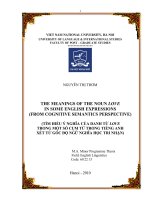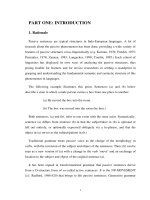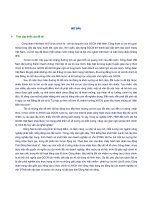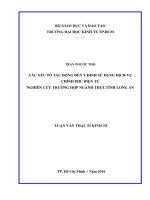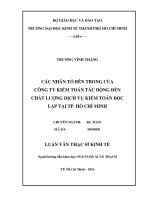(Luận văn thạc sĩ) các giới từ in, on,at trong tiếng anh và tiếng việt dưới góc độ ngữ nghĩa học tri nhận m a thesis linguistics 602202
Bạn đang xem bản rút gọn của tài liệu. Xem và tải ngay bản đầy đủ của tài liệu tại đây (661.78 KB, 57 trang )
VIETNAM NATIONAL UNIVERSITY, HANOI
UNIVERSITY OF LANGUAGES AND INTERNATIONAL STUDIES
FACULTY OF GRADUATE AND POSTGRADUATE STUDIES
HÀ THỊ TUYẾT
PREPOSITIONS “IN, ON, AT” IN ENGLISH AND VIETNAMESE
FROM A COGNITIVE SEMANTIC PERSPECTIVE
CÁC GIỚI TỪ “IN, ON, AT” TRONG TIẾNG ANH VÀ TIẾNG VIỆT
DƯỚI GÓC ĐỘ NGỮ NGHĨA HỌC TRI NHẬN
M.A. MINOR PROGRAMME THESIS
Field: English Linguistics
Code: 60220201
HANOI – 2017
VIETNAM NATIONAL UNIVERSITY, HANOI
UNIVERSITY OF LANGUAGES AND INTERNATIONAL STUDIES
FACULTY OF GRADUATE AND POSTGRADUATE STUDIES
HÀ THỊ TUYẾT
PREPOSITIONS “IN, ON, AT” IN ENGLISH AND VIETNAMESE
FROM A COGNITIVE SEMANTIC PERSPECTIVE
CÁC GIỚI TỪ “IN, ON, AT” TRONG TIẾNG ANH VÀ TIẾNG VIỆT
DƯỚI GÓC ĐỘ NGỮ NGHĨA HỌC TRI NHẬN
M.A. MINOR PROGRAMME THESIS
Field: English Linguistics
Code: 60220201
Supervisor: Dr. Hà Cẩm Tâm
HANOI – 2017
DECLARATION
I hereby declare that the thesis, entitled “Prepositions “in, on, at” in
English and Vietnamese from a cognitive semantic perspective” has been
carried out in partial fulfillment of the requirements for the degree of Master of
Art at the University of Languages and International Studies. This work is
original and all the sources that I have used or quoted have been indicated and
acknowledged by means of complete references.
Hanoi – 2017
Hà Thị Tuyết
i
ACKNOWLEDGEMENTS
During the period of completing the Master thesis, the author has received
the support of a great number of people.
First and foremost, I wish to express my deepest gratitude to Dr. Ha Cam
Tam, my supervisor, who has generously given me insightful guidance and
valuable feedback during the process of carrying out the thesis, without which
this thesis would be far from completed.
I would also like to give my sincere gratitude to all of the lecturers at
ULIS –VNU, Hanoi for their scholarly knowledge and enthusiasm in their
lectures.
My profound thanks are also to all my friends and classmates in the cohort
23, who have always stayed by my side, given me constructive comments and
perked me up every time I need.
Last but not least, my heartfelt thanks go to my family, especially my
husband and my daughter, for their immeasurable support and continual
encouragement.
The Master thesis could not have been fulfilled without them.
ii
ABSTRACT
In light of reference frames used in spatial location coined by cognitive
linguist Talmy in 2000, this thesis is intended to investigate the semantic
features of English prepositions of place in, at, on with reference to
Vietnamese. The reason for this choice of topic is that spatial conceptualization
is basic in a human being‘s development and it reveals meaningful insights into
the patterns of thinking and viewing the world in cross-linguistics. This paper
compiles a set of typical cases using prepositions ―in‖, ―on‖ and ―at‖ in the two
languages, pointing out the ways they are conceptualized and making a
comparison from the data collected. The final aim is to give valid construals
about spatial conceptualization processes that native speakers employ in the
language. The results show that these prepositions in both languages have some
similarities and differences in term of semantics.
iii
LIST OF ABBREVIATIONS
NP
Noun phrase
LM
Landmark
LMs
Landmarks
TR
Trajector
TRs
Trajectors
iv
TABLE OF CONTENTS
DECLARATION
i
ACKNOWLEDGEMENTS
ii
ABSTRACT
iii
LIST OF ABBREVIATIONS
iv
TABLE OF CONTENTS
v
PART 1: INTRODUCTION
1
1. Statement of the Problem
1
2. Aims of the Study
2
3. Scope of the study
2
4. Research question
2
5. Organization of the study
2
PART 2: DEVELOPMENT
4
CHAPTER 1: LITERATURE REVIEW
4
1.1. An overview of Cognitive Linguistics and Cognitive Semantics
4
1.2. Spatial Prepositions and Semantic Perspectives on Spatial Prepositions
7
1.3. Spatial domain and dimensionality
8
1.4. Spatial characteristics of Trajectors and Landmarks
10
1.5. Metaphor and spatial preposition
11
1.6. Overview of related studies
14
CHAPTER 2: METHODOLOGY
17
2.1. Data collection
17
2.2. Analytical framework
17
2.3. Research methods
21
CHAPTER 3: DATA ANALYSIS AND FINDINGS
22
3.1. Conceptualization of ―in‖, ―on‖, ―at‖ in English
22
v
3.1.1. In
22
3.1.2. On
27
3.1.3. At
30
3.2. Conceptualization of ―in‖, ―on‖, ―at‖ in Vietnamese
32
3.3. Similarities and Differences between English and Vietnamese Spatial Cognition
39
3.3.1. Similarities
39
3.3.2. Differences
39
PART 3: CONCLUSION
42
3.1. A summary of the findings
42
3.2. Limitation and recommendation for further studies
43
REFERENCES
45
APPENDIX: A sample of a page in the novel The Great Gasby
vi
I
PART 1: INTRODUCTION
In this part, the author presents the statement of the problem, aims of the
study, the research question, and organization of the study.
1. Statement of the Problem
Nowadays, English has been widely used all over the world. The language
is currently considered as a second language in many countries. However,
learners of English as a Foreign Language (EFL) have a lot of difficulties in
conceptualize and perceive the language. Beside essential notional categories
namely nouns, verbs, adjectives and adverbs, such functional categories as
prepositions are also challenging to learners of this language. EFL leaners often
try to relate the use of English prepositions to their mother tongue prepositional
system.
It is worth noting that cognitive semantics is concerned with investigating
the relationship between experience, the conceptual system, and the semantic
structure encoded by language (Lakoff, 1987). As far as spatial prepositions are
concerned, cross-language research in cognitive semantics has shown that
although spatial cognition exists in any language, there are differences in
strategies of spatial conceptualization employed by people using each language.
The linguistic encoding of spatial concepts in different language is different
(Choi & Bowerman, 1991).
The preposition ―in, on, at‖ are very popular spatial prepositions in
English. It is essential to grasp the related meanings of these English
prepositions within the framework of cognitive semantics and this way
1
immensely understand what native speakers conceptualize spatial relations of the
physical world objects and how they map from these spatial domains to nonspatial domains. How these prepositions can be understood in different
collocations have so far not been thoroughly investigated. The thesis hopes to
contribute to the research into how different language express the various spatial
relations that hold between entities in the world.
2. Aims of the Study
This study investigates the prepositions ―in, on, at‖ in English and
Vietnamese from cognitive perspectives. Therefore, it is aimed at:
- Finding the ways the prepositions ―in, on, at‖ are conceptualized in
English and in Vietnamese and their differences, if any.
3. Scope of the study
The study is limited to investigating the ways the prepositions ―in, on, at‖
are conceptualized in English and in Vietnamese and identifying the differences
between the spatial conceptualization in these two languages, if any.
4. Research question
The following question is proposed in the current research:
- To what extend do English and Vietnamese differ in the conceptualization
of prepositions ―in, on, at‖ regarding the cognitive semantic perspective?
5. Organization of the study
The present paper is organized in four main parts. The INTRODUCTION
part is devoted to presenting statement of the problem, aims of the study, scope
of the study, significance of the study, research questions and organization of the
study. The DEVELOPMENT part is subdivided into three chapters: CHAPTER
2
1 discusses the ―LITERATURE REVIEW‖ which provides necessary and
relevant general theoretical concepts for the main contents of the study;
CHAPTER 2: ―METHODOLOGY‖ includes data collection, analytical
framework and research method of the study; CHAPTER 3: ―DATA
ANALYSIS AND FINDINGS‖
comprises data analysis, findings and discussion. The CONCLUSION part
demonstrates the conclusions of this piece of research, pedagogical implications,
and suggestions for further studies.
3
PART 2: DEVELOPMENT
CHAPTER 1: LITERATURE REVIEW
1.1. An overview of Cognitive Linguistics and Cognitive Semantics
1.1.1 Cognitive linguistics
Cognitive linguistics is an approach to language that is based on our
experience of the world and the way we perceive and conceptualize it. Ungerer
& Schmid (1996)
Gilles Fauconnier (2006) describes cognitive linguistics as: ―Cognitive
linguistics goes beyond the visible structure of language and investigates the
considerably more complex backstage operations of cognition that create
grammar, conceptualization, discourse, and thought itself. The theoretical
insights of cognitive linguistics are based on extensive empirical observation in
multiple contexts, and on experimental work in psychology and neuroscience.
Results of cognitive linguistics, especially from metaphor theory and conceptual
integration theory, have been applied to wide ranges of nonlinguistic
phenomena.‖
1.1.2 Cognitive semantics
Cognitive semantics is a branch of cognitive linguistics. Like cognitive
linguistics, cognitive semantics is not a single unified theory. It studies language
as a container and an organizer within the human mind. This approach takes the
relationship between meaning and human mind as its central concern.
Vyvyan Evans (2006:156), cognitive semantics sees linguistic meaning as
a manifestation of conceptual structure: the nature and organization of mental
4
representation in all its richness and diversity, and this is what makes it a
distinctive approach to linguistic meaning.
Talmy (2000:4) describes cognitive semantics and the main methodology
as: ―Research on cognitive semantics is research on conceptual content and its
organization in language and hence, on the nature of conceptual content and
organization in general‖.
According to Talmy (2000), Lakoff & Johnson (1980), and Geerearts
(1999), there are four guiding principles that cognitive semantics conform to: (i)
Conceptual structure is embodied; (ii) Semantic structure is conceptual structure;
(iii) Meaning representation is encyclopedic; (iv) Meaning construction is
conceptualization.
The first guiding principle means that the nature of conceptual organization
arises from bodily experience. Because of the nature of our bodies, including our
neuro-anatomical architecture, we have a species specific view of the world
(Geerearts, 1999; Talmy, 1985, 2000). In other words, our construal of reality is
mediated, in large measure, by the nature of our embodiment. We can only talk
about what we can perceive and conceive, and the things that we can perceive
and conceive derive from embodied experience. From this point of view, the
human mind must bear the imprint of embodied experience. This position holds
that conceptual is a consequence of the nature of our embodiment and thus is
embodied.
The second guiding principle; that is to say, semantic structure is
conceptual structure, asserts that language refers to concepts in the mind of the
speaker rather than, directly, to entities which inhere in an objectively real
5
external
world.
Put
another way,
semantic structure (the
meanings
conventionally associated with words and other linguistic units) can be equated
with conceptual structure (i.e., concepts) (Rosch, 1973). However, the claim that
semantic structure can be equated with conceptual structure does not mean that
the two are identical. Instead, cognitive semanticists hold that the meanings
associated with linguistic units such as words, for example, form only a subset of
possible concepts in the minds of speaker-hearers. After all, we have many more
thoughts, ideas and feelings than we can conventionally encode in language
(Evans, 2006; Evans & Green, 2006).
The third guiding principle holds that semantic structure is encyclopedic in
nature. This means that lexical concepts do not represent neatly packaged
bundles of meaning. Rather, they serve as ‗points of access‘ to vast repositories
of knowledge relating to a particular concept or conceptual domain (Langacker,
1987). Of course, to claim that lexical concepts are ‗points of access‘ to
encyclopedic meaning is not to deny that words have conventional meanings
associated with them. Nevertheless, cognitive semanticists argue that the
conventional meaning associated with a particular linguistic unit is simply a
‗prompt‘ for the process of meaning construction: the ‗selection‘ of an
appropriate interpretation against the context of the utterance.
The forth guiding principle is that language itself does not encode meaning.
Instead, words (and other linguistic units) are only ‗prompts‘ for the construction
of meaning (Geerearts, 1999). Accordingly, meaning is constructed at the
conceptual level. Meaning construction is equated with conceptualization, a
process whereby linguistic units serve as prompts for an array of conceptual
6
operations and the recruitment of background knowledge. Meaning is a process
rather than a discrete thing that can be packaged by language.
1.2. Spatial Prepositions and Semantic Perspectives on Spatial Prepositions
Merriam-Webster (2013) defines preposition as, ―a word or group of words
that is used with a noun, pronoun, or noun phrase to show direction, location, or
time, or to introduce an object‖.
Spatial Prepositions have been the focus of much recent syntactic and
semantic research. Recent semantic works have thoroughly investigated spatial
prepositions and their dimensions of meaning.
According to Cuycken (1993), spatial prepositions indicate relation
between two arguments x & y, how they are related to each other in space. More
specifically, in a large number of cases, spatial prepositions describe the place/
position of x by using the argument y as reference. It can be understood that they
serve to locate x with respect to y, or rather, the place of y. For example,
preposition on in “the pen on the book” locates the pen (argument x) with
respect to the book (argument y). This means that it assigns x to a place or
location which coincides with the place taken up by top of the book (a place
which is assumed to be known).
- Prepositional meaning is defined as a core sense. All the uses of a
preposition are reduced to a core sense, which is the one introduced in the
lexicon, and the context provides other aspects of meaning which do not belong
to the preposition (Leech, 1969; Bennett, 1975). There is only one meaning that
occurs in a variety of contexts. These contexts introduce nuances of meaning that
7
can be assigned to the preposition, but the core sense is in all of them (Miller &
Johnson-Laird, 1976; Herskovits, 1985; Wierzbicka, 1993).
- Prepositions are polysemous. There is a prototypical sense and other nonprototypical senses. There are two approaches. There is a preference rule system
that determines the prototype (Ciencki, 1989). The different senses of a
preposition can be derived from a basic image-schema by means of family
resemblances and image schema transformations (Brugman, 1980; Lindner, 1983;
Hawkins, 1984; Lakoff, 1987; Boers, 1996).
1.3. Spatial domain and dimensionality
Each kind of conceptualization, regardless of its degree of complexity, can
function as a domain or context in the characterization of semantic structure.
Whether naturally or culturally established, it is not a textual, syntagmatic or
pragmatic context, but rather a field of experience or human knowledge is
referred. Each domain has its particular specifications or parameters. There are
very basic domains, such as time, space, smell, color, etc., and very complex
ones, related to marginal or more elaborated fields of experience. The domain in
which prepositions are conceptualized is three-dimensional space: its
specifications and parameters will completely determine the semantic analysis
that is appropriate. The three canonical dimensions of space (height, length and
width) are conceptualized in language, and more specifically, in prepositional
usage, as zero dimensional, when the LM entity is conceived of as dimensional,
when the LM entity is conceptualized as having a vertical or horizontal axis, as
in ‗the child by the flagpole‘ and ‗a cruise down the river‘, two dimensional,
when the LM entity is conceptualized as an extended entity, as in ‗the cows in
8
the field‘, and three-dimensional, when the area is conceptualized as having
volume, as in ‗the marble in the box‘. Not only the landmark entity but also the
trajector is conceptualized accordingly in relation to its canonical dimensions:
however, in prepositional usage it is the LM entity that bears directly upon the
choice of preposition which is appropriate in each case. The concept of
dimensionality derives directly from the intrinsic characteristics of the spatial
domain that prepositions describe. I have already pointed out how canonical
spatial dimensions are categorized linguistically, via a process of cognitive
abstraction. We can conceive of three dimensions: vertical, horizontal, and
extension. In practice, this means that objects can be conceptualized as a dot,
irrelevant as regards dimensionality (0 dimensions), as a line (dimension 1), as
an extended area (dimension 2), or as an area with volume (dimension 3). In the
course of my analysis, it has not always been an easy matter to determine exactly
how physical objects are conceptualized in language in relation to their canonical
dimensions. What is involved is a process of abstraction in close association with
the speaker‘s capacity to construe the mental images that are involved in
prepositional usage. As such, some degree of flexibility is necessary in relation
to this type of mental imagery. Speakers categorize subjectively, in the sense that
other factors, such as the speaker‘s knowledge of the world, cultural constraints,
etc. will necessarily come into play.
Characterization of spatial conceptualization
In, on, at are the basic and most general spatial prepositions in English. At
is considered as the most ―neutral‖ place preposition which denotes place as a
point of orientation regardless of its physical shape. As in the example at the
9
airport, at takes the airport as an orientation point for some trajectors but does
not denote whether the trajector is near, inside or on top of the airport area.
Preposition on denotes physical contact between trajector and landmark, and
necessitates viewing the landmark as one-dimensional space (a line) or twodimensional space (a surface). In denotes the enclosure of the trajector in the
landmark and views the landmark as two- or three-dimensional space (a space or
a volume)
1.4. Spatial characteristics of Trajectors and Landmarks
A detailed discussion of these concepts is not relevant for the purposes of
this paper; however, some should be made of them to point out how they affect
the analysis in terms of dimensionality and motion, with an indication of the
general features that these entities present. The terms TR and LM are used in
their conventional meanings (Langacker, 1987). As regards prepositional usage,
the TR entity carries out the relation described by the preposition, whereas the
LM is the entity in relation to which the relation is carried out.
The asymmetry pertaining to the internal structure of relational
predications is connected with salience of its participants. The status of the
participants is not equal as one of them is a figure in the relational predication (is
to be elaborated by the figure of the conceptualization), whereas other salient
participants, often referred to as secondary figures, are called by landmarks. The
very term ‗landmark‘ is motivated by the fact that‖ they are naturally viewed (in
prototypical instances) as providing points of reference for locating the trajector‖
(Langacker 1987:217)
10
(1) He put a finger through the crack.
In this example, ‗finger‘ is the TR and ‗crack‘ is the LM or reference point
which permits the location of the TR. The term TR typically suggests motion;
this is the case in predicates that involve processes. However, the definition of
TR does not necessarily entail either physical or abstract motion: the term can be
applied to both dynamic and stative relations. Consider the following example
from Talmy (forthcoming), denoting a stative relation:
(2) Those rods go through the ceiling.
All relational predicates involve an LM as part of their profile, regardless
of whether the LM is syntactically specified or not. (Langacker 1987). Linguistic
convention allows for non-specification of the LM in cases like the following:
when it is unique in its class; when the context, either pragmatic or textual,
permits a clear identification, or in the case of reflexivity.
For the analysis, the following characteristics were borne in mind when
describing the TR and LM entities: dimensions of TR and LM, shape of TR and
LM, if it displays a vertical, horizontal or extended form, whether the TR is
singular or multiplex, whether it is a stative or dynamic TR, if there is contact or
not between TR and LM, if there is reflexivity, deixis, covering, type of
trajectory, if there is real or implied motion, if there is end-point focus, etc.
1.5. Metaphor and spatial preposition
The study of metaphorical processes is basic to cognitive studies. Cognitive
linguistics makes no clear distinction between literal and figurative language,
and it is maintained that the latter should be accommodated as an integral part of
11
linguistic organization. Metaphorical conceptualization is regarded as a factor
that may interact with grammatical processes, and is viewed as an important
semantic phenomenon. The existence of cultural and experiential metaphors
conventionally sanctions and allows for the regular metaphorization of spatial
uses of prepositions (Lakoff and Johnson 1980).
According to Ungerer and Schmid (1999: 120), metaphor is a ―mapping of
the structure of source model onto a target model‖. The source and the target
domain of a metaphor belong to two different cognitive domains. To complicate
things these belong to different superordinate domains and it has not been stated
precisely what a domain is, neither when one is different from another nor when
exactly a domain is superordinate (Barcelona, 2003: 32)
Cognitive semantics does not view metaphor as a speaker‘s violation of
rules of competence (Reddy, 1993; Lakoff & Johnson, 1980; Lakoff & Turner,
1989; Lakoff, 1993). Metaphor is a means whereby ever more abstract and
intangible areas of experience can be conceptualized in terms of the familiar and
concrete. It is motivated by a search for understanding. One cognitive domain
can be understood, or even created, in terms of components more usually
associated with another cognitive domain (Lakoff & Johnson, 1980).
Lakoff and Johnson divided the metaphorical concepts into three groups
which are presented as follows:
a. Structural metaphors
The group of structural metaphors is said to be the biggest group. Different
parts of experiences which are complex but too abstract are conceptualized with
12
the help of simple but known experiences, e.g. the example DISCUSSION IS
WAR.
a rhetorical fought out battle
a guerrilla warfare of words
In these examples, one tries to explain the abstract concept discussion with
the help of the concrete concept war and typical words which are linked to it.
b. Orientational metaphors
Another group is the orientational metaphors. These structure concepts
linearly, orienting them with respect to non-metaphorical linear orientations.
Those metaphors are based on the orientation in space. Therefore, a spatial
relationship is made for a concept. This relationship is normally based on our
experiences of the physical space. For examples:
BEING HAPPY IS UP/BEING SAD IS DOWN
c. Ontological metaphors
The last group, the ontological metaphors, is based on the experience with
physical objects. Those experiences can be identified and categorized as entities
restricted by a surface. So we can categorize those things that normally do not
have such a boundary by using those entities. We set up artificial boundaries.
There are many kinds of ontological metaphors with different purposes one of
them being the concept abstracts are things such as question or art:
a series of questions
The world is full of art.
Another concept is the container metaphors. According to Lakoff and
Johnson, human beings are containers with boundaries and an orientation of
inside and outside. This orientation is also used for other physical objects. But
13
also non-physical objects (e.g. events, actions, activities, states) can be
understood by transforming them into physical objects with definite boundaries.
In the case of activities, states, and emotions that could mean:
He fell in love.
We will be out of the trouble soon.
The problem will be dealt with in the next discussion.
A very important group of ontological metaphors is those that describe
something as a person, a personification. There are innumerable examples like:
This theory explains everything.
The facts are against it.
A metaphor is a mapping of the structure of a source model onto a target
model. Based on the concrete world, abstract phenomena is conceptualized.
Conceptualization of models of abstract categories is grounded in more concrete
experience with people, objects, actions and events. This is the mechanism
which the semantic categories in, on and at activate to be used in abstract
domains. In the characterization of the abstract usage of prepositions, basic
image schemas are used for the spatial conceptualization of abstract domains.
1.6. Overview of related studies
Most English prepositions are inherently polysemous and hard to accurately
predict - a feature that is important for machine learning. As such, prepositions
have received relatively less attention compared to nouns, verbs or adjectives
from computational linguists.
Cienki (1989) compared the English prepositions in, on and at and their
Polish and Russian equivalents. He found that the uses of these spatial
prepositions across the three languages do not fully overlap. For example, in
14
English, the preposition in is used for the expression a tent in a clearing, whereas
in Russian and Polish the equivalent words for on are used. He interpreted this
difference as driven by different conventional conceptualizations of reference
objects across languages. Cienki‘s analysis was based mainly on the comparison
of translation equivalents and on the researcher‘s own linguistic intuitions about
how to describe the same spatial scenes in other languages. Other researchers
have used more controlled comparisons and have elicited the linguistic
descriptions of certain spatial scenes from actual language users.
There is also a popular acceptance among linguists of the core meaning of
―at‖ as being a zero-dimensional locative expression, implying the location of an
entity as being a point Bennett goes even further suggesting that when used in
their spatial sense, ―on‖ and ―in‖ are the two- and three-dimensional counterparts
of ―at‖ respectively, but also points out the necessity of a relative variability of
the size of the zerodimensional location described by ―at‖ (Benett, 1975). In the
example ‗John is at the market‘, other relationships such as proximity or
containment may also be used to indicate John‘s position relative to the market,
allowing the market to be perceived either as a zero-dimensional point of
reference, or as an actual three-dimensional building. This more flexible
interpretation of ―at‖ does not deviate from its core meaning, and is also
consistent with the belief that people do not perceive the world as strictly
comprising of points, lines, or other two- or three dimensional geometric shapes.
Herskovits (1986) argues for a similar interpretation of ―at‖ in examples
such as ‗She parked the car at the corner‘, where the conceptually-mapped
objects in question—corners of intersection and car—need not be exactly co-
15
located, but can be within an acceptable distance, still validating the description
at the corner.
The next set of investigations pointing to the important role of language in
the spatial conceptualization comes from a series of crosslinguistic descriptive
and empirical studies of meanings of spatial terms. Specifically, a considerable
number of studies have looked at two basic topological relationships —
containment (expressed in English mainly by preposition in) and support
(expressed in English mainly by preposition on). The general finding is that the
categorization of containment and support varies crosslinguistically.
In addition, Tran (2010) mentioned several differences between English
and Vietnamese prepositions in terms of semantics and pragmatics. First, when
describing the higher position, they take the contact meaning between trajector
and landmark into consideration. For example, they distinguish the meaning of
on, above and over. Meanwhile, Vietnamese people almost do not pay attention
to this aspect. They just use the only word trên. Second, when talking about the
relation between above and under, English people are always aware of whether
or not trajector is in the vertical reference of the landmark‘s area.
There have been efforts to examine how people understand and perceive the
terms used in such frameworks to express the spatial relations. From the basis of
the previous studies, it can be seen that the investigation of prepositions of place
‗in‘, ‗at‘, ‗on‘ and their Vietnamese equivalents have not discussed so far in both
languages, English and Vietnamese. A research relating prepositions ‗in‘, ‗at‘,
‗on‘ in English and Vietnamese from a cognitive semantic perspective has been
chosen for my thesis.
16
CHAPTER 2: METHODOLOGY
This chapter is devoted to presenting the data for analysis, analytical
framework and the methods that will be deployed. The data sub-section
describes the steps for collecting data from the novel that have been chosen for
analysis. The analytical framework will be used in the data analysis.
2.1. Data collection
In this analysis which follows, I concentrate on the prepositions ―in, on, at‖
in expressions. The data are manually collected from the novel Great Gatsby
(1925), an English well-known literary work by F. Scott Fitzgerald. The reason
why the author chooses this work is that it is familiar to the readers and
represents natural languages. Due to the limited time as well as the scope of the
study, only occurrences of ―in, on, at‖ in form of in + NP, on + NP, and at + NP,
where ―in, on, at‖ play the role of prepositions rather than adverbs or affixes,
were taken. Those examples which are found to be repeated are excluded. From
the novel, 134 instances of preposition in, 127 instances of preposition on, 107
instances of preposition at are found.
2.2. Analytical framework
The framework of this thesis is based on the particular notions in cognitive
semantics, namely, image schemas, prototype theory and radial category, and
metaphorical meaning extension.
Image Schemas
Because of our physical experience of being and acting in the world of
perceiving the environment, moving our bodies, exerting and experiencing force,
17

